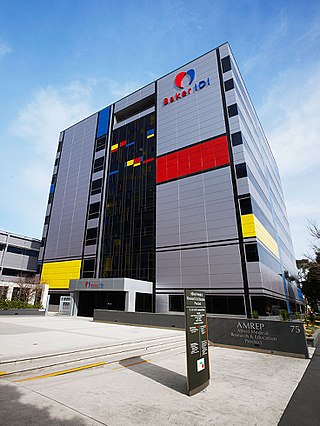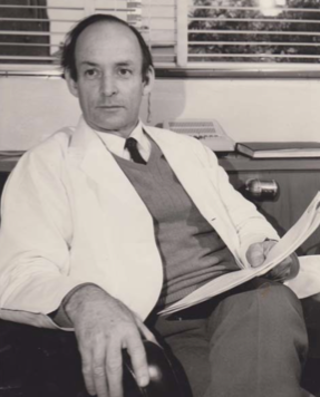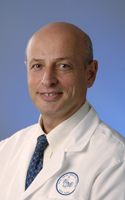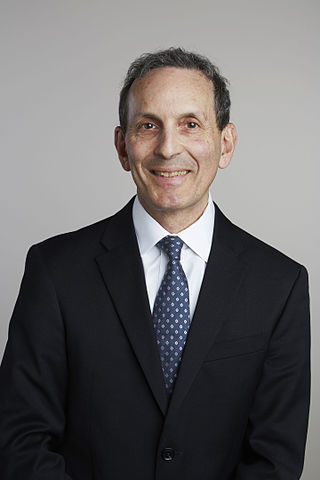
Endocrinology is a branch of biology and medicine dealing with the endocrine system, its diseases, and its specific secretions known as hormones. It is also concerned with the integration of developmental events proliferation, growth, and differentiation, and the psychological or behavioral activities of metabolism, growth and development, tissue function, sleep, digestion, respiration, excretion, mood, stress, lactation, movement, reproduction, and sensory perception caused by hormones. Specializations include behavioral endocrinology and comparative endocrinology.
Thyroid-stimulating hormone (also known as thyrotropin, thyrotropic hormone, or abbreviated TSH) is a pituitary hormone that stimulates the thyroid gland to produce thyroxine (T4), and then triiodothyronine (T3) which stimulates the metabolism of almost every tissue in the body. It is a glycoprotein hormone produced by thyrotrope cells in the anterior pituitary gland, which regulates the endocrine function of the thyroid.
Pediatric endocrinology is a medical subspecialty dealing with disorders of the endocrine glands, such as variations of physical growth and sexual development in childhood, diabetes and many more.

Zvi Laron is an Israeli paediatric endocrinologist. Born in Cernăuţi, Romania, Laron is a professor emeritus at Tel Aviv University. In 1966, he described the type of dwarfism later called Laron syndrome. His research opened the way to the treatment of many cases of growth hormone disorders. He was the first to introduce the multidisciplinary treatment for juvenile diabetes.
The Kolling Institute is located in the grounds of the Royal North Shore Hospital in St Leonards, Sydney Australia. The institute, founded in 1920, is the oldest medical research institute in New South Wales.

The Garvan Institute of Medical Research is an Australian biomedical research institute located in Darlinghurst, Sydney, New South Wales. Founded in 1963 by the Sisters of Charity as a research department of St Vincent's Hospital, it is now one of Australia's largest medical research institutions, with approximately 750 scientists, students and support staff.

Donald Frederick Steiner was an American biochemist and a professor at the University of Chicago.

The Baker Heart and Diabetes Institute, commonly known as the Baker Institute, is an Australian independent medical research institute headquartered in Melbourne, Victoria. Established in 1926, the institute is one of Australia's oldest medical research organisations with a historical focus on cardiovascular disease. In 2008, it became the country's first medical research institute to target diabetes, heart disease, obesity and their complications at the basic, clinical and population health levels.
Christopher Carl Goodnow is an immunology researcher and the current executive director of the Garvan Institute of Medical Research. He holds the Bill and Patricia Ritchie Foundation Chair and is a Conjoint Professor in the faculty of medicine at UNSW Sydney. He holds dual Australian and US citizenship.
Derek LeRoith is a South African endocrinologist and Professor of Medicine and the current Chief of the Hilda and J. Lester Gabrilove, M.D. Division of Endocrinology, Diabetes and Bone Disease and Director of the Metabolism Institute of the Mount Sinai Medical Center in New York City. He is an international expert in insulin-like growth factor-1 (IGF-1).

Kenneth Adie Ferguson was an Australian veterinary scientist.

Leonid Poretsky is a Russian-born American endocrinologist. His research interests include mechanisms of insulin action in the ovary, endocrinological aspects of AIDS, and clinical outcomes in diabetes. He has authored over 100 publications and has served on the National Institutes of Health's review committees and on the editorial boards of the Journal of Clinical Endocrinology and Metabolism and other endocrine journals.
Shashank R. Joshi is an Indian endocrinologist, diabetologist and medical researcher, considered by many as one of the prominent practitioners of the trade in India. He was honoured by the Government of India, in 2014, by bestowing on him the Padma Shri, the fourth highest civilian award, for his services to the field of medicine. He is a part of the COVID-19 Task Force for the state of Maharashtra, India.

Daniel Joshua Drucker is a Canadian endocrinologist. A Fellow of the Royal Society, he is a professor of medicine at the Lunenfeld-Tanenbaum Research Institute, Mount Sinai Hospital, Toronto. He is known for his research into intestinal hormones and their use in the treatment of diabetes and other metabolic diseases.

Creswell John Eastman is the Clinical Professor of Medicine at Sydney University Medical School, Principal of the Sydney Thyroid Clinic and Consultant Emeritus to the Westmead Hospital. Eastman is an endocrinologist and has directed or conducted research and public health projects into elimination of iodine deficiency disorders (IDD) in Malaysia, Indonesia, Laos, Cambodia, Thailand, several Pacific Islands, Hong Kong, China and Tibet and Australia. For his work in remote areas of China, he has been dubbed the "man who saved a million brains".
Lesley Veronica Campbell is an Australian endocrinologist and Professor of Medicine with a special interest in clinical diabetes, appetite and metabolism. She is a principal research fellow at the Garvan Institute of Medical Research in Sydney, Australia.
Professor Susan J. Clark is an Australian biomedical researcher in epigenetics of development and cancer. She was elected a Fellow of the Australian Academy of Science in 2015, and is a National Health and Medical Research Council (NHMRC) Senior Principal Research Fellow and Research Director and Head of Genomics and Epigenetics Division at the Garvan Institute of Medical Research. Clark developed the first method for bisulphite sequencing for DNA methylation analysis and used it to establish that the methylation machinery of mammalian cells is capable of both maintenance and de novo methylation at CpNpG sites and showed is inheritable. Clark's research has advanced understanding of the role of DNA methylation, non-coding RNA and microRNA in embryogenesis, reprogramming, stem cell development and cancer and has led to the identification of epigenomic biomarkers in cancer. Clark is a founding member of the International Human Epigenome Consortium (IHEC) and President of the Australian Epigenetics Alliance (AEpiA).
Katherine Samaras is the laboratory head at the Garvan Institute of Medical Research. She holds positions at St Vincent's Clinic, and University of New South Wales, as well as the University of Notre Dame.
Louise Maple-Brown is an Australian endocrinologist. She is a clinical researcher at the Royal Darwin Hospital, serving as the hospital's Head of Endocrinology and as NHMRC Practitioner Fellow with the Menzies School of Health Research at Charles Darwin University. She leads a clinical research program within the Wellbeing and Preventable Chronic Diseases division of Menzies with a focus on diabetes in Indigenous Australians and provides clinical diabetes services to urban and remote Northern Territory communities.
Joseph Edward Rall was an American endocrinologist and research director at the National Institutes of Health. He was an expert on the thyroid gland, particularly its proteins and its relationship with radioactive iodine.









